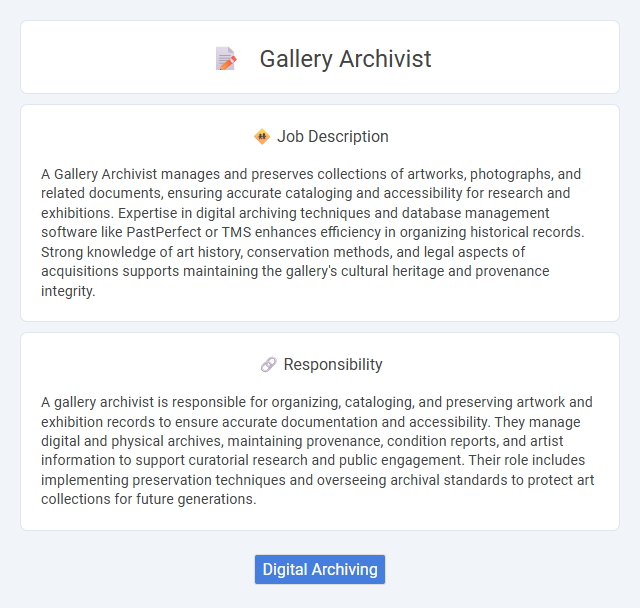
A Gallery Archivist manages and preserves collections of artworks, photographs, and related documents, ensuring accurate cataloging and accessibility for research and exhibitions. Expertise in digital archiving techniques and database management software like PastPerfect or TMS enhances efficiency in organizing historical records. Strong knowledge of art history, conservation methods, and legal aspects of acquisitions supports maintaining the gallery's cultural heritage and provenance integrity.
Individuals with strong attention to detail and an interest in art history or archival science are likely suitable for a gallery archivist role. Those who thrive in organized, methodical environments and can handle delicate, often aged materials with care may find this job fulfilling. However, people who prefer fast-paced, highly social roles might not find this position aligns well with their strengths or preferences.
Qualification
A Gallery Archivist must possess a degree in art history, library science, or archival studies, combined with extensive knowledge of preservation techniques and digital cataloging systems. Proficiency in metadata standards such as Dublin Core and experience with database management software like ArchivesSpace or TMS are essential. Strong organizational skills and attention to detail are critical for maintaining accurate records and facilitating research access.
Responsibility
A gallery archivist is responsible for organizing, cataloging, and preserving artwork and exhibition records to ensure accurate documentation and accessibility. They manage digital and physical archives, maintaining provenance, condition reports, and artist information to support curatorial research and public engagement. Their role includes implementing preservation techniques and overseeing archival standards to protect art collections for future generations.
Benefit
Gallery archivist positions likely offer the benefit of preserving valuable cultural and historical artifacts, which may provide a deep sense of fulfillment. The role probably allows access to unique collections that enhance professional expertise and contribute to academic research. Working in this environment could also foster connections with artists and historians, potentially opening pathways for career advancement.
Challenge
Gallery archivist roles likely involve the challenge of meticulously organizing and preserving diverse collections, often requiring in-depth knowledge of art history and archival standards. Navigating the delicate balance between accessibility and conservation of fragile materials poses a probable ongoing difficulty. Managing digital transformation while maintaining the integrity of physical records could represent another significant challenge in this field.
Career Advancement
A Gallery Archivist manages, preserves, and organizes art collections, ensuring accurate documentation and accessibility for research and exhibitions. Developing expertise in digital archiving technologies and specialized conservation techniques can significantly enhance career growth opportunities. Advancement often leads to senior curatorial roles, museum directorships, or specialized consultancy positions within the cultural heritage sector.
Key Terms
Digital Archiving
Gallery archivists specializing in digital archiving manage and preserve digital assets such as high-resolution images, video documentation, and metadata for artworks. They utilize digital asset management systems (DAMS), ensuring accurate cataloging, secure storage, and easy retrieval of digital files to maintain the gallery's historical and cultural records. Proficiency in digital preservation standards, file format compatibility, and data migration techniques is essential to prevent data loss and support long-term accessibility.
 kuljobs.com
kuljobs.com